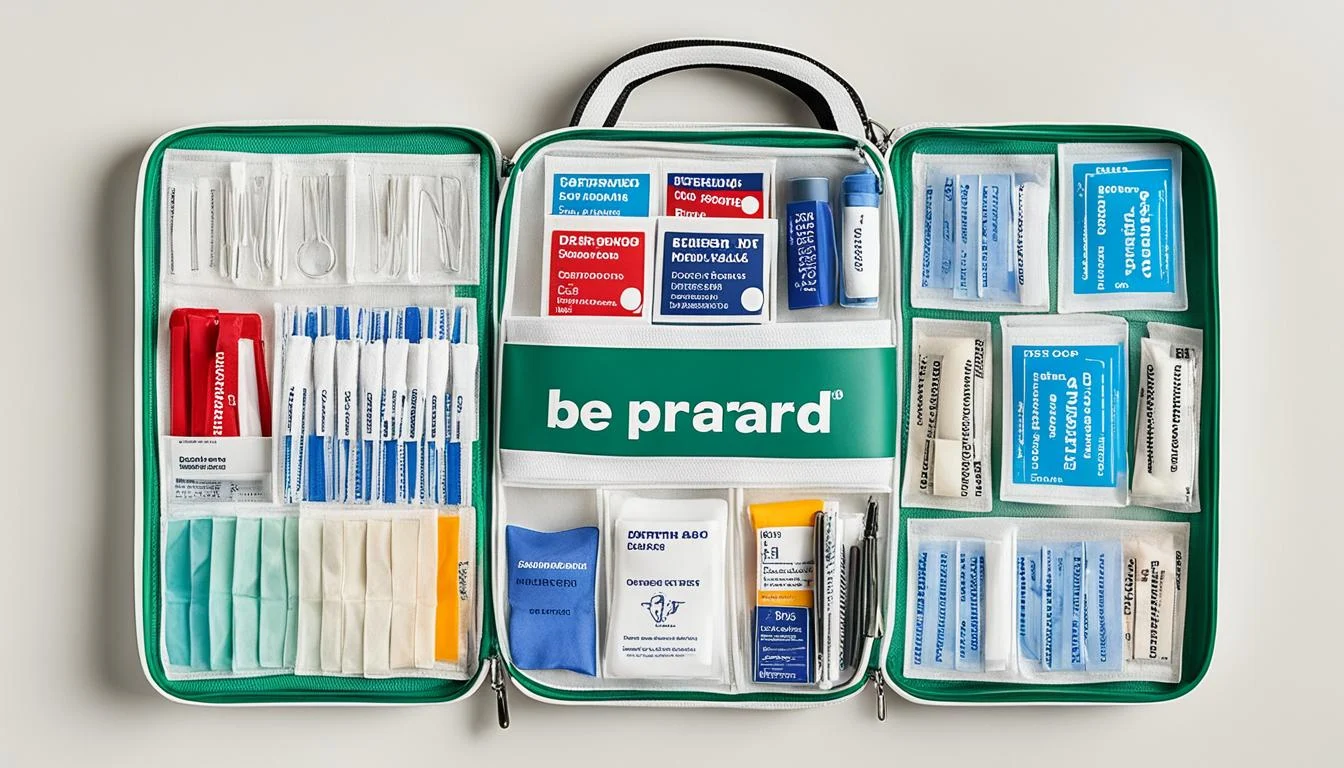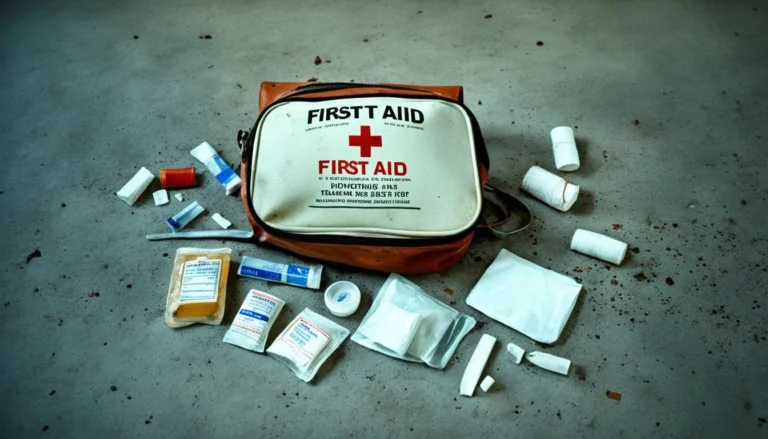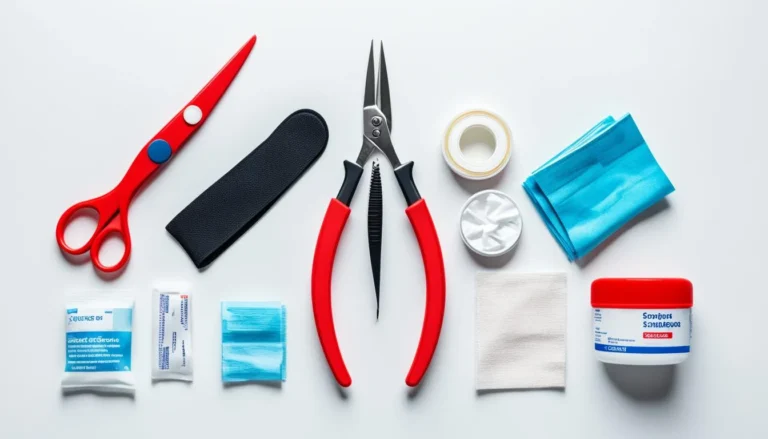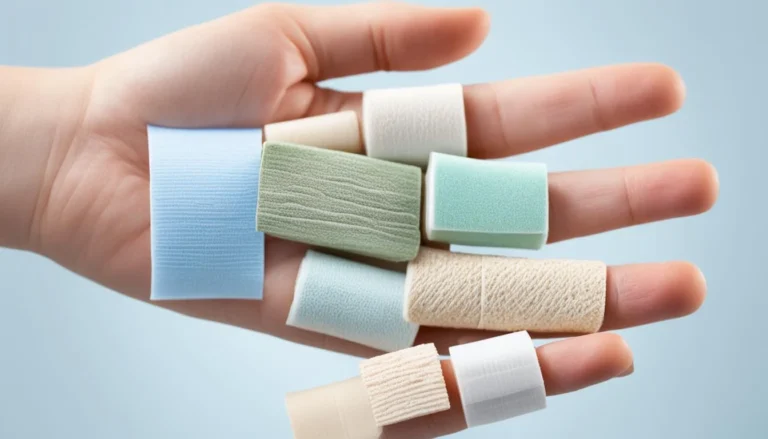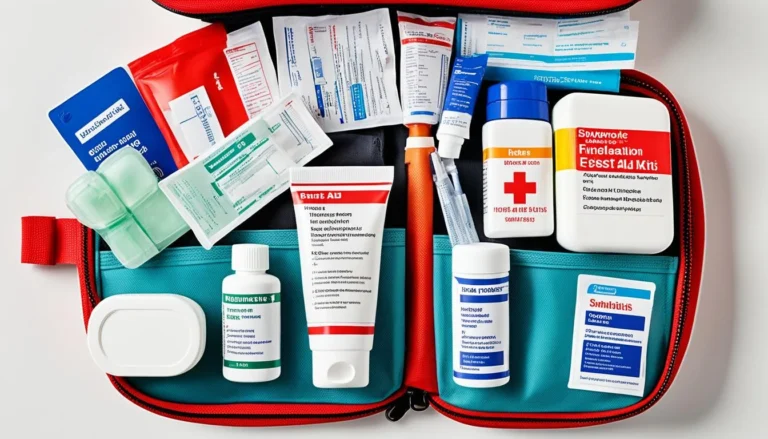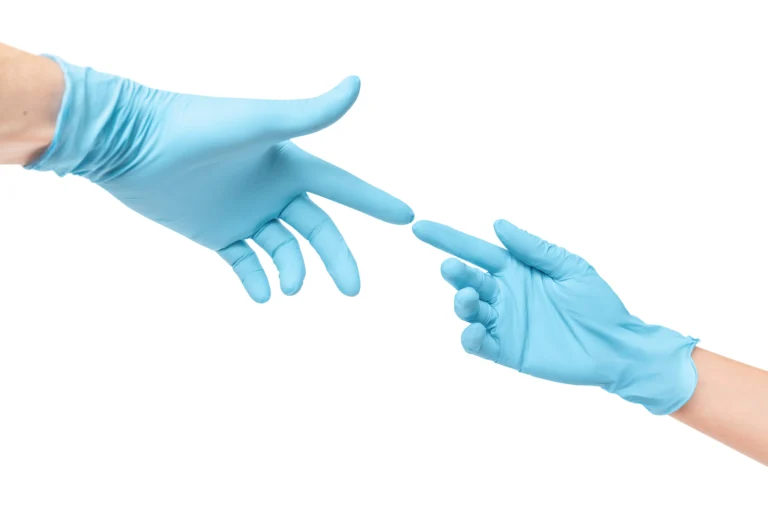Essential 14 Items In A First Aid Kit – Be Prepared
Being ready for emergencies is critical for staying safe. Kate Elkins, who knows a lot about emergencies, says having the right first aid items is key. These help you offer quick help for cuts or big injuries before the experts get there.
Your first aid kit should suit what you need based on health issues and who’s using it. It’s smart to check and update your kit often. This way, everything crucial is ready and easy to reach. Being well-prepared with a good first aid kit is the first step to dealing with unexpected health troubles.
Key Takeaways
- A well-equipped first aid kit can provide immediate assistance in emergencies.
- Personal health considerations should influence the contents of the kit.
- Organisation and accessibility of items are crucial during emergencies.
- Regular reviews and replenishments ensure the kit remains effective.
- Being well-prepared enhances overall emergency readiness.
Introduction to First Aid Kits: Why They Are Important
First aid kits have changed a lot in the last hundred years. They are still very important. A filled first aid kit helps anyone give first aid until the doctor arrives. It is key in how well we can respond to emergencies.
“Stop the Bleed” is one programme that teaches important skills. It shows you how to handle medical emergencies. This mix of tools and knowledge is crucial for keeping everyone safe at home or outside.
The Brisbane First Aid group helps people know how to use first aid kits. Their lessons make sure you have the right tools and know-how for emergencies. Being ready makes a big difference in medical crises.
A first aid kit is needed for small cuts to big accidents. It should fit the needs of you or your family. Check and update it often to be sure it can help when needed.
What Are 14 Items In A First Aid Kit
Putting together a first aid kit means picking a range of items. They should cover all kinds of emergencies. This way, you’re ready for both small cuts and big injuries. Here’s what you should have in your first aid kit:
- Gauze Pads: Essential for controlling bleeding and covering wounds.
- Trauma Dressing: Used in severe wounds to manage heavy bleeding.
- Thermal Blankets: Crucial for treating shock by maintaining body heat.
- Burn Gel Dressing: Provides immediate relief and protects against contamination in burn injuries.
- Cold Packs: Helps alleviate pain, reduce inflammation, and minimise swelling from minor injuries.
- Triangular Bandages: Versatile for creating slings, splints, or pressure dressings.
- Antiseptic Wipes: Vital for cleaning and disinfecting wounds to prevent infection.
- Cardboard Splints: Used to immobilise fractures until professional help is available.
- Band-aids: Useful for covering small cuts and abrasions.
- Paramedic Scissors: Designed for cutting bandages and clothing during emergencies.
- Antimicrobial Wipes: Helps to sanitise hands and surfaces before and after handling injuries.
- Vinyl Gloves: Necessary for protecting against contamination while treating wounds.
- Gauze Rolls: Used for securing dressings and providing additional wound care.
- First Aid Tape: Essential for securing bandages and dressings in place.
Here’s a table with more info on these items and what they’re for:
| Item | Primary Use |
|---|---|
| Gauze Pads | Control bleeding, cover wounds |
| Trauma Dressing | Manage severe bleeding |
| Thermal Blankets | Treat shock by maintaining body heat |
| Burn Gel Dressing | Provide relief and protection for burns |
| Cold Packs | Reduce pain, inflammation, and swelling |
| Triangular Bandages | Slings, splints, and pressure dressings |
| Antiseptic Wipes | Clean and disinfect wounds |
| Cardboard Splints | Immobilise fractures |
| Band-aids | Cover small cuts and abrasions |
| Paramedic Scissors | Cut bandages and clothing |
| Antimicrobial Wipes | Sanitise hands and surfaces |
| Vinyl Gloves | Protect against contamination |
| Gauze Rolls | Secure dressings and provide wound care |
| First Aid Tape | Secure bandages and dressings |
Gauze Pads and Their Importance
Gauze pads are key in looking after wounds effectively. They help control bleeding and stop infections. These basic medical tools are crucial for dealing with anything from small cuts to bigger injuries. They should be in every first aid kit.
Usage of Gauze Pads
Gauze pads are used differently based on the wound. They can stop bleeding by adding pressure. After a wound has been cleaned, they work as a shield. They keep the wound dry, which is vital in avoiding infection and helping a wound to heal quickly.
Different Sizes of Gauze Pads
There’s a variety of gauze pad sizes available. You can find them in sizes like 4×4 and 5×9 inches. The smaller sizes are perfect for tiny cuts and scrapes. On the other hand, the bigger sizes are great for more serious wounds. This range means gauze pads fit the needs of any injury, ensuring they’re a must-have in any medical kit.
| Size | Application |
|---|---|
| 4×4 inches | Standard wounds, minor cuts, abrasions |
| 5×9 inches | Larger wounds, moderate injuries |
Trauma Dressing for Severe Bleeding
Trauma dressings are vital for emergency bleeding control. They are needed when first aid alone can’t stop the severe bleeding. Their big size and special design help cover and manage large wounds. In moments of severe bleeding, they are essential.

When bleeding could mean a major loss of blood, trauma dressings are life-saving. They are an important part of first aid treatment. Trauma dressings keep the wound stable. This gives first responders more time until doctors can help. They are key in severe wound management, lessening the threat of losing too much blood.
When to Use Trauma Dressing
Knowing when to use trauma dressings is crucial for any emergency. They shine in tough situations like severe cuts, deep stabs, or other serious wounds. Using them fast is critical for emergency bleeding control. It can be the difference between life and death before professional help arrives.
Thermal Blankets to Treat Shock
Thermal blankets, also known as survival blankets, are key in shock treatment. They offer vital emergency thermal insulation. This insulation helps stabilise those in shock from various causes.
Shock can happen from trauma, loss of blood, or being in cold. The blankets keep body heat in, which is essential for helping these individuals.
Function of Thermal Blankets
Survival blankets are very useful. They reflect the body’s heat back. This stops the patient from getting too cold, helping in the first steps of shock treatment.
They work by keeping warmth close. This is important in sudden emergencies. It lowers the danger of the body getting too cold.
| Key Feature | Benefit |
|---|---|
| Lightweight | Easy to carry and transport in an emergency kit |
| Reflective Material | Provides excellent heat retention and emergency thermal insulation |
| Compact Size | Convenient to store and use when needed |
In short, thermal blankets are a must in shock treatment. They offer life-saving insulation. Having these blankets in your emergency kit is crucial for effective shock management.
Using Burn Gel Dressing for Burns
It’s very important to treat burns quickly and well. Burn gel dressings are made for this, giving a cool and soothing feel.

Application Process
In first aid for burns, cooling properly is key. Use lukewarm water for 20 minutes. Don’t use ice, it can make things worse. This helps lower the burn’s temperature and makes it hurt less.
After cooling, softly dry with a clean cloth. Take off any loose clothes or jewellery near the burn. But, don’t remove anything stuck on the burn.
Then, put the cooling gel dressings on top of the burn. These dressings protect the wound from dirt. They also keep it moist to help heal faster. This process also reduces pain.
| Step | Action | Purpose |
|---|---|---|
| 1 | Cool the burn with lukewarm water | Reduces temperature and pain |
| 2 | Dry the area with a clean cloth | Prepares the skin for dressing application |
| 3 | Remove loose clothing/jewellery | Prevents further irritation |
| 4 | Apply burn gel dressing | Protects and cools the burn area |
Following these burn treatment methods helps the injury heal well. This improves the chance of a quick recovery.
Cold Packs for Bumps, Bruises, and Swelling
Cold packs are a must-have in first aid kits. They help treat injuries by lessening pain and swelling. This is key for common issues like bumps, bruises, and swelling. Cold therapy is quick and easy to use, helping in both small and big injuries.
Types of Cold Packs
There are many cold packs to choose from, each for different purposes.
- Instant Cold Packs: These activate instantly by squeezing, perfect for quick use.
- Reusable Cold Packs: Keep them frozen and use them over and over. They’re good for the environment and for ongoing reducing inflammation.
Application Tips
Using cold packs rightly is important for the best results. Here are tips for applying them:
- Always wrap the pack in cloth to avoid frostbite on the skin.
- Use the pack on and off in 15-20 minute bits to protect your skin.
- Keep an eye on how the skin reacts while and after you use the cold pack.
Cold packs are essential for reducing inflammation and giving quick relief. They are a vital part of every first aid kit.
The Versatile Triangular Bandage
The triangular bandage is a vital part of any good first aid kit, known for being so versatile. It can be used as a sling support for arm or shoulder injuries. It’s also great as an immobilisation device for fractures and sprains.
This bandage is not just for support. It can be used to stop bleeding when rolled up. This shows its role in dealing with various types of injuries. It’s perfect for many first aid needs.
It’s simple and made from a big piece of cloth shaped like a triangle. This design makes it easy to use for anyone. Both health professionals and regular people find it very helpful in emergencies. Really, a complete first aid kit must have a triangular bandage. It showcases its key place in being ready for emergencies.

